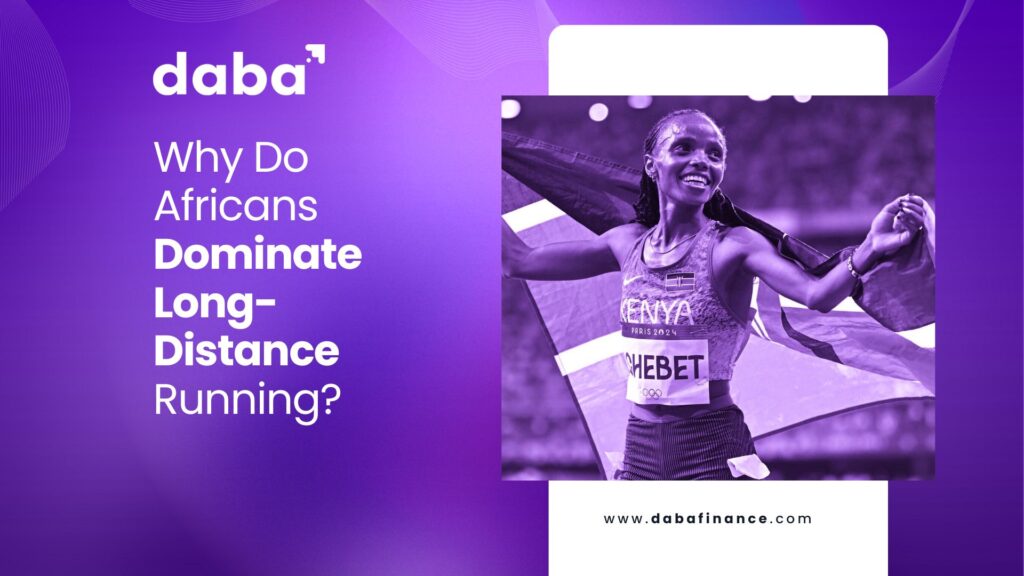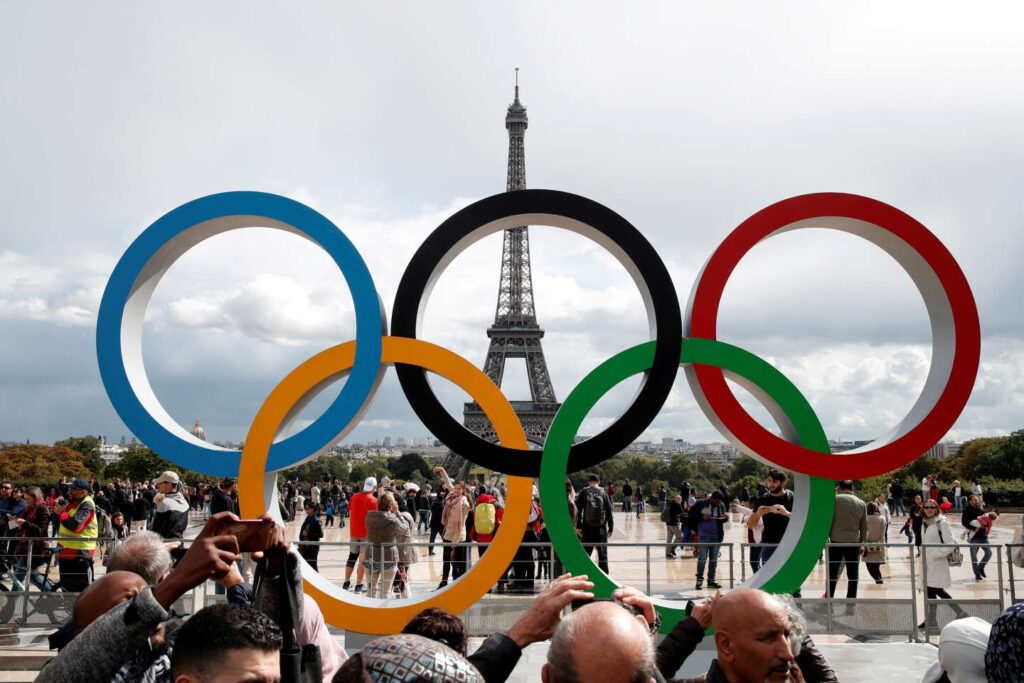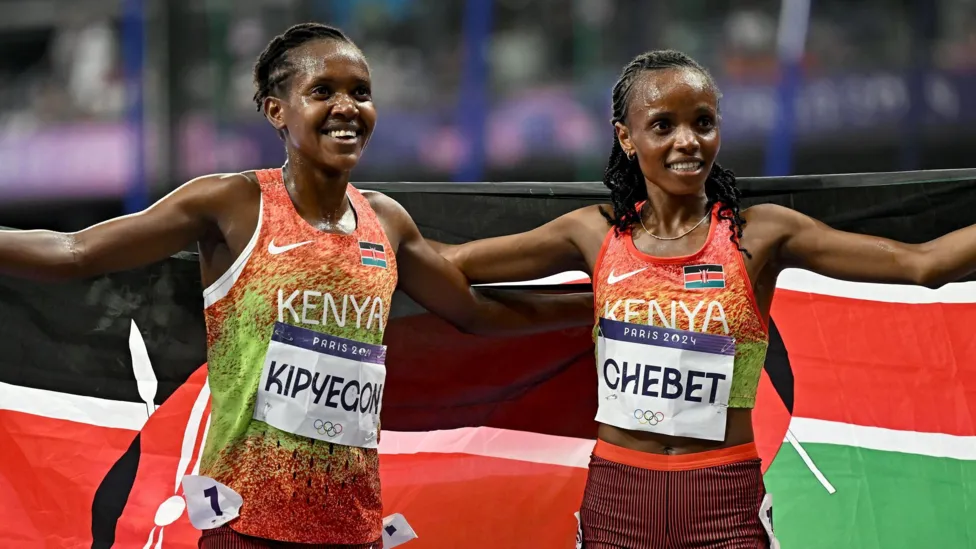Why Do Africans Dominate Long-Distance Running?
8 min Read August 12, 2024 at 10:30 AM UTC

The just concluded summer games reaffirmed Africa’s, and particularly East Africa’s, status as a powerhouse in long-distance running with Kenya leading the continent.
The just concluded Paris 2024 Olympics saw African nations, particularly those in East Africa, further cement their reputation as powerhouses in long-distance running.
While the overall medal count was dominated by traditional sporting giants like the United States and China, African countries made their presence felt, especially on the track.
Medal Count
The United States topped the medal table with 40 gold medals and a total of 126 medals, narrowly edging out China, which finished with 40 golds but fewer silver medals. Japan, Australia, and host nation France rounded out the top five.
Africa amassed 39 medals, distributed among 12 participating nations. Kenya led the way, finishing 17th in the overall standings with 4 gold, 2 silver, and 5 bronze medals for a total of 11.
Other African countries in the medal table included Algeria (39th with 2 gold, 1 bronze), South Africa (44th with 1 gold, 3 silver, 2 bronze), and Ethiopia (47th with 1 gold, 3 silver).
Egypt and Tunisia tied for 52nd place with one gold, one silver, and one bronze each. Botswana and Uganda shared 55th place, both securing one gold and one silver. Morocco finished 60th with one gold and one bronze, while Côte d’Ivoire, Cape Verde, and Zambia each won a single bronze medal.

Africa’s Long-Distance Runners Shine at Paris 2024 Olympics
The success of African nations at the Paris Games was largely driven by their performances in athletics, particularly in long-distance events. Of the 13 gold medals won by African countries, 8 came in athletics, with East African runners claiming the lion’s share in distance races.
Kenyan athletes led the charge, with Beatrice Chebet securing two gold medals in the Women’s 5000m and 10000m events. Emmanuel Wanyonyi added to Kenya’s gold tally in the Men’s 800m (Kenyan men have dominated the 800m event since 2008), while Faith Kipyegon claimed gold in the Women’s 1500m. Ethiopia’s Tamirat Tola continued the East African success by winning gold in the Men’s marathon.
The dominance extended beyond just the gold medals. Kenya’s Faith Kipyegon also secured silver in the Women’s 5000m, while Ronald Kwemoi took silver in the Men’s 5000m. Ethiopia’s Berihu Aregawi and Tsige Duguma won silver medals in the Men’s 10000m and Women’s 800m respectively.
Sign up here for our weekly Next Frontier newsletter
Uganda joined the medal table with Joshua Cheptegei’s gold in the Men’s 10000m, further solidifying East Africa’s stronghold on long-distance events.
The pattern of East African success extended to other long-distance disciplines as well. In the 3000m steeplechase, traditionally dominated by runners from this region, Kenya’s Faith Cherotich and Abraham Kibiwot both secured bronze medals in the women’s and men’s events respectively.
Ethiopia’s Peruth Chemutai claimed silver in the Women’s 3000m steeplechase, while Morocco’s Soufiane El Bakkali took gold in the men’s event, showing that North Africa is also competitive in this discipline.

The marathon events saw continued East African excellence, with Kenya’s Benson Kipruto and Hellen Obiri both securing bronze medals in the men’s and women’s marathons respectively, while Ethiopia’s Tigst Assefa claimed silver in the women’s marathon.
This impressive haul of medals across a range of long-distance events demonstrates the continued dominance of East African runners at the highest level of competition. Their success spans from the track events of 800m up to the grueling marathon, showcasing their versatility and endurance across different distances and terrains.
Ethiopia also made its mark, winning gold in the men’s 10,000m.
Uganda’s Joshua Cheptegei, who won gold in the 5000m, added to East Africa’s impressive haul in distance events. Morocco’s sole gold medal came from Soufiane El Bakkali in the men’s 3000m steeplechase.
Why East Africans Excel in Long-Distance Running
The victories in long-distance events are not merely coincidental.
For decades, East African runners, particularly those from Kenya and Ethiopia, have dominated the world stage in distances from 3,000m upwards. The reasons behind this sustained success are multifaceted and have been the subject of much research and speculation.
While there isn’t a single definitive answer, experts point to a combination of factors that contribute to their dominance in long-distance events.
One key factor often cited is the high-altitude environment in which many of these athletes grow up and train.
Kenya’s Rift Valley, for instance, sits at an average elevation of 1,500 meters (4,921 feet) above sea level. Ethiopia’s central plateau ranges even higher, from 4,200 to 9,800 feet. Training at such altitudes naturally increases lung capacity and red blood cell count, providing a significant advantage when competing at lower elevations.
Diet also plays a crucial role. The typical diet of Kenyan and Ethiopian runners is high in complex carbohydrates and low in fat, providing the ideal fuel for endurance activities. Staples like ugali (a stiff porridge made from maize or millet flour), green vegetables, and lean proteins form the backbone of their nutritional intake.
Physical characteristics contribute as well. Many successful East African runners have a lean, efficient body type that is particularly well-suited to distance running. Research has shown that the average Kenyan runner’s legs are about 400 grams lighter than those of their European counterparts, resulting in an energy saving of around 8% over long distances.
You can follow Daba’s reporting on Africa on WhatsApp. Sign up here
Cultural and socioeconomic factors cannot be overlooked. In many East African communities, running is seen as a viable path out of poverty. Success stories of runners who have lifted their entire villages out of hardship through their earnings serve as powerful motivation for young athletes.
The training regimen of East African runners is often characterized by its simplicity and intensity. Many athletes grow up running long distances to and from school, sometimes barefoot, which some researchers believe contributes to more efficient running form.
Adharanand Finn, author of “Running with the Kenyans,” spent time living and training in Kenya’s Rift Valley. He observed that in towns like Iten, running is a way of life. With thousands of full-time runners training together, including Olympic and world champions, the environment fosters a unique culture of excellence and mutual inspiration.

The Accessibility of Running
In addition, one key factor in the success of African nations in running events that is hard to overlook is the sport’s accessibility.
Unlike many Olympic disciplines that require expensive equipment or specialized facilities, running is a relatively low-cost sport. This accessibility allows talented athletes to emerge even from areas with limited resources.
Dr. Yannis Pitsiladis, a professor of sport and exercise science at the University of Brighton, notes: “Running is a natural human movement. It doesn’t require the infrastructure that many other sports do. This makes it possible for talent to flourish even in areas without significant financial investment in sports.”
Moreover, the psychological edge gained from years of success should not be underestimated. East African runners often enter races with a strong belief in their abilities, which can be intimidating to their competitors.
However, it’s important to note that while East African runners dominated the long-distance events, African success at the Paris Olympics extended beyond just running. Gold medals were also won in boxing, wrestling, and swimming, showcasing the continent’s diverse sporting talents.
Sign up here for our weekly Next Frontier newsletter
Looking Ahead
The performance of African athletes, particularly those from East Africa, at the Paris 2024 Olympics continues a trend that has been building for decades. Since Abebe Bikila’s barefoot marathon victory for Ethiopia in 1960, African runners have been a force to be reckoned with in long-distance events.
As the Olympic flame was extinguished in Paris, the legacy of East African running excellence burned brighter than ever. Their continued success serves as an inspiration not only to aspiring athletes across Africa but to runners worldwide. It also raises intriguing questions about the interplay of genetics, environment, culture, and training in shaping world-class athletes.
Looking ahead to the 2028 Los Angeles Olympics, eyes will be on whether East African runners can maintain their grip on long-distance events. Given their performance in Paris and the deeply ingrained culture of running excellence in countries like Kenya and Ethiopia, it seems likely that we’ll see more record-breaking performances and medal-winning runs from these remarkable athletes in the years to come.
This material has been presented for informational and educational purposes only. The views expressed in the articles above are generalized and may not be appropriate for all investors. The information contained in this article should not be construed as, and may not be used in connection with, an offer to sell, or a solicitation of an offer to buy or hold, an interest in any security or investment product. There is no guarantee that past performance will recur or result in a positive outcome. Carefully consider your financial situation, including investment objective, time horizon, risk tolerance, and fees prior to making any investment decisions. No level of diversification or asset allocation can ensure profits or guarantee against losses. Articles do not reflect the views of DABA ADVISORS LLC and do not provide investment advice to Daba’s clients. Daba is not engaged in rendering tax, legal or accounting advice. Please consult a qualified professional for this type of service.

Next Frontier
Stay up to date on major news and events in African markets. Delivered weekly.
Pulse54
UDeep-dives into what’s old and new in Africa’s investment landscape. Delivered twice monthly.
Events
Sign up to stay informed about our regular webinars, product launches, and exhibitions.

